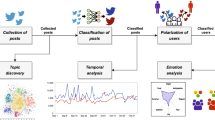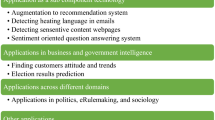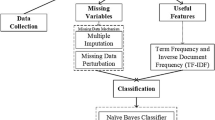Abstract
Sentiment analysis explores the views, perceptions and feelings of people concerning entities like subjects, goods, organizations, resources and individuals. The opinion of some people in social network influences the opinion behavior and thoughts of other people. They are known as influential user. In this article, both the sentiment analysis and identification of influential user are proposed. Initially, Twitter data are preprocessed by proposing weighted partition around medoids (WPAM) with artificial cooperative search (WPAM-ACS) which extracts topics from Twitter data through dynamic clustering (DC). For sentiment classification, NLP has been used in many works. The main issue of using NLP for sentiment classification is that many languages do not have the adequate resources to develop NLP models. So, a fuzzy deep neural network (FDNN) is proposed in this paper for sentiment classification, because FDNN effectively handles the uncertainties and noises in tweet data than other state of the arts. Emotional conformity is a metric that refers to how people from an emotional point of view agree with another person. It is given as additional input to FDNN along with the tweets for sentiment classification. Finally, influential users are detected by temporal influential model (TIM) formulated as likelihood function using incremental logistic regression (ILLR) in which user’s opinion sequence is considered for identification of influential user. In the experimental results, sentiment analysis is evaluated in terms of precision, recall and F-measure and proved that the proposed DC–FDNN sentiment classification is better than fixed clustering and NLP (FC–NLP)-based sentiment classification. Influential user detection using TIM-ILLR on opinion sequences which are identified by DC-FDNN is evaluated in terms of accuracy and proved that TIM-ILLR is better than other methods such as maximum likelihood estimation (MLE), support vector regression (SVR) and logistic regression (LR).





Similar content being viewed by others
References
Alharbi ASM, de Doncker E (2018) Twitter sentiment analysis with a deep neural network: an enhanced approach using user behavioral information. Cogn Syst Res 54:50–61
Araque O, Corcuera-Platas I, Sanchez-Rada JF, Iglesias CA (2017) Enhancing deep learning sentiment analysis with ensemble techniques in social applications. Expert Syst Appl 77:236–246
Chaudhuri A, Ghosh SK (2016) Sentiment analysis of customer reviews using robust hierarchical bidirectional recurrent neural network. In: Artificial intelligence perspectives in intelligent systems, Springer, Cham, pp 249–261
Chen C, Li W, Gao D, Hou Y (2017) Exploring interpersonal influence by tracking user dynamic interactions. IEEE Intell Syst 32:28–35
Chong WY, Selvaretnam B, Soon LK (2014) Natural language processing for sentiment analysis: an exploratory analysis on tweets. In: IEEE 4th international conference on artificial intelligence with applications in engineering and technology (ICAIET), pp 212–217
Civicioglu P (2013) Artificial cooperative search algorithm for numerical optimization problems. Inf Sci 229:58–76
de Amorim RC, Fenner T (2012) Weighting features for partition around medoids using the minkowski metric. In International symposium on intelligent data analysis Springer, Berlin, Heidelberg, pp 35–44
Deng Y, Ren Z, Kong Y, Bao F, Dai Q (2017) A hierarchical fused fuzzy deep neural network for data classification. IEEE Trans Fuzzy Syst 25:1006–1012
Dhanya NM, Harish UC (2018) Sentiment analysis of twitter data on demonetization using machine learning techniques. In: Computational vision and bio inspired computing springer, Cham, pp 227–237
Dohaiha HH, Prasad PWC, Maag A, Alsadoon A (2018) Deep learning for aspect-based sentiment analysis: a comparative review. Expert Syst Appl 118:272–299
Eliacik AB, Erdogan N (2018) Influential user weighted sentiment analysis on topic based microblogging community. Expert Syst Appl 92:403–418
Hasan A, Moin S, Karim A, Shamshirband S (2018) Machine learning-based sentiment analysis for twitter accounts. Math Comput Appl 23:1–15
Heikal M, Torki M, El-Makky N (2018) Sentiment analysis of Arabic tweets using deep learning. Proc Comput Sci 142:114–122
Jianqiang Z, Xiaolin G, Feng T (2017) A new method of identifying influential users in the micro-blog networks. IEEE Access 5:3008–3015
Jianqiang Z, Xiaolin G, Xuejun Z (2018) Deep convolution neural networks for twitter sentiment analysis. IEEE Access 6:23253–23260
Kao LJ, Huang YP (2016) Social network influential users' sentiment degree measurement based on fuzzy logic. In: IEEE Intconf fuzzy theory Its Appl (iFuzzy), pp 1–6
Kauer AU, Moreira VP (2016) Using information retrieval for sentiment polarity prediction. Expert Syst Appl 61:282–289
Li G, Liu F (2010) A clustering-based approach on sentiment analysis. International conference on INTELLIGENT systems and knowledge engineering (ISKE). IEEE, New York, pp 331–337
Mohammadi A, Saraee M (2018) Finding influential users for different time bounds in social networks using multi-objective optimization. Swarm Evol Comput 40:158–165
Musto C, Semeraro G, Polignano M (2014) A comparison of lexicon-based approaches for sentiment analysis of microblog posts. In: Proceedings of 8th int workshop on inf filter retr Pisa, Italy
Na JC, Kyaing WYM (2015) Sentiment analysis of user-generated content on drug review websites. J Inf Sci Theory Pract 3(1):6–23
Pandey AC, Rajpoot DS, Saraswat M (2017) Twitter sentiment analysis using hybrid cuckoo search method. Inf Process Manag 53:764–779
Shalini L, Sravya GN (2018) Analysis of health-tweets using K-means clustering. Int Res J Eng Tech 5:2074–2077
Sun Q, Wang N, Zhou Y, Luo Z (2016) Identification of influential online social network users based on multi-features. Int J Pattern Recognit Artif Intell 30(1659015–1):1659015–1659016
Suzuki Y, Kaneda Y, Mineno H (2015) Analysis of support vector regression model for micrometeorological data prediction. Comput Sci Inf Tech 3:37–48
Tang X, Miao Q, Quan Y, Tang J, Deng K (2015) Predicting individual retweet behavior by user similarity: a multi-task learning approach. Knowl Based Syst 89:681–688
Wagh R, Punde P (2018) Survey on sentiment analysis using twitter dataset. In: IEEE second international conference on electronics, communication and aerospace technology (ICECA), pp 208–211
Funding
This work was not funded.
Author information
Authors and Affiliations
Corresponding author
Ethics declarations
Conflict of Interest
All authors declare that they have no conflict of interest.
Additional information
Publisher's Note
Springer Nature remains neutral with regard to jurisdictional claims in published maps and institutional affiliations.
Rights and permissions
About this article
Cite this article
Ramya, G.R., Bagavathi Sivakumar, P. An incremental learning temporal influence model for identifying topical influencers on Twitter dataset. Soc. Netw. Anal. Min. 11, 27 (2021). https://doi.org/10.1007/s13278-021-00732-4
Received:
Revised:
Accepted:
Published:
DOI: https://doi.org/10.1007/s13278-021-00732-4




